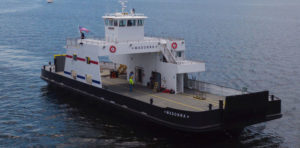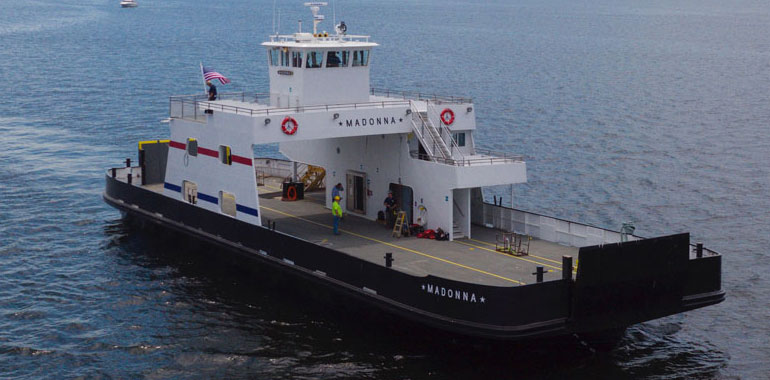For most of this century, the Washington Island Ferry Line had a single icebreaking vessel available for winter runs across Lake Michigan’s Death’s Door Passage. The arrangement caused some sleepless nights for company President Hoyt Purinton.
He should rest a little easier this year now that a second ice-hardened ferry has joined the fleet.

“We haven’t had the luxury of a backup vessel should our primary winter boat, Arni J. Richter, have mechanical issues during the ice operating season,” said Purinton, the fourth-generation president of the ferry company based on Washington Island, Wis. “The year-round community … depends on daily service every day of the year, and this vessel strengthens our position during the most operationally challenging period of the year.”
Fincantieri Bay Shipbuilding completed the 124-foot Madonna in July using plans developed by Seacraft Design. Both firms are based in Sturgeon Bay, Wis., and they are among nearly a dozen vendors and suppliers from the Badger State used in Madonna’s construction and outfitting.
The 1,600-hp double-ended newbuild is the largest and most versatile ferry in Washington Island Ferry’s five-vessel fleet. It was designed with 15 feet of overhead clearance to accommodate larger vehicles, including oversized construction equipment and special cargoes. It can hold 28 vehicles and up to 149 passengers.
As of August, the ferry line was still breaking in the new boat. But the captains have noticed some nice surprises in its performance. “Underway, it is quiet and incredibly smooth,” Purinton said. “There is absolutely no vibration. Although we haven’t had much rough weather, in a beam sea it is a comfortable ride.”
Washington Island Ferry is the sole transportation link for people, vehicles, delivery trucks, construction equipment and more between its namesake island and the Door County peninsula. The island has about 700 year-round residents, and demand for ferry service surges in the summer as seasonal visitors arrive.
The 4.5-mile route crosses Death’s Door Passage, a strait that earned its name from a Native American legend that was passed along to French explorers who visited the region in the 1600s. Nautical charts for this section of Lake Michigan still refer to the waterway by its original French name, Porte des Morts. Numerous shipwrecks have occurred here over the years, burnishing its reputation as a difficult passage.
Although Lake Michigan remains open throughout the year, Green Bay is 75 to 100 percent covered in ice for several months in a typical winter. Washington Island ferries sometimes get lucky and can run in the same trackline for a week or longer. More often, the wind or currents change, pushing the ice fields around.
“This is both good and bad at the same time,” Purinton said. “Newer ice fields don’t get the time to knit together and (they) provide leads or seams to work through. On the bad side, when enough wind gets behind a field with room to run, it creates above-surface windrows and subsurface stacking.”
The 104-foot Arni J. Richter will remain the company’s primary icebreaker. It has proven itself repeatedly since delivery in 2003 from Bay Shipbuilding. The 2,000-hp ferry has run through stacked ice deeper than its 10’4” draft. It makes 2 to 3 mph even in foot-thick, blue new-plate ice. Madonna will play a supporting role to Arni, particularly in late March when demand rises but the ice hasn’t fully melted.
Mark Pudlo, president of Seacraft Design, designed Madonna based on input from the ferry company. The hull is longitudinally framed throughout, with closely spaced stiffeners running lengthwise and transverse frames more widely spread out. The result is a stronger, sturdier hull well suited for operating in ice conditions.
“Structurally, it is very stout,” Pudlo said in a recent interview, adding that the vessel is built to ABS Ice Class C0 standards. “Most of the hull plating is half-inch, and the stiffening inside is pretty substantial. There is a lot of mass in the boat, which makes it ride comfortably when not breaking ice.”
Madonna was designed with a gradual stem angle and profile that should allow it to ride up onto the ice and then break through. The main deck hangs over the model bow much like an aircraft carrier, while the overhang at amidships is 22 inches on each side.
The propulsion system on Madonna consists of twin EPA Tier 3 Caterpillar C32 engines generating 800 hp each. The Cat engines are paired with four-blade Kahlenberg stainless-steel propellers through Aqualoy 17 shafts and Twin Disc reduction gears. Electrical power comes from two 30-kW Northern Lights generators. The ferry’s maximum speed is about 13 knots, and it cruises at 10 knots in optimal conditions.
R.W. Fernstrum & Co., based just across the border in Menominee, Mich., supplied the keel coolers. Each is built into recessed pockets on the hull protected by ice guards, with fairings built into the hull to keep ice away. The sea chests are located inside the keel cooler pockets to filter out and melt any ice that accumulates around the intake.
Madonna’s maximum power is 400 hp less than Arni J. Richter, something Purinton attributed to striking a balance between cost and the performance needed, with allowances in the engineering spaces and engine models to increase horsepower in the future if needed. Caterpillar also discontinued the 3508 engine line that powers Arni. Installing Cat mains that met Tier 4 emissions standards would have required aftertreatment, creating “a whole rat’s nest of problems,” he said.
Madonna’s main deck is split into four vehicle lanes, and its extra length compared to Arni J. Richter allows for an additional row of cars in each lane. Overhead clearance, at 15 feet, is a foot higher than its predecessor. That seemingly small difference lets the new vessel carry one-off cargoes and special equipment to and from the island that previously would not fit. Less than a week after it entered service, Madonna carried a massive 100-ton rock-crushing unit.
The passenger spaces are located on the second and third decks. The enclosed second level has 27 Springfield Marine seats, while the exposed third level has bench seating made by Hi Tec Fabrication of Sturgeon Bay. The interior spaces are heated to keep passengers comfortable during the cold winter months. Stainless-steel handrails are installed throughout the vessel for durability and ease of maintenance.
The wheelhouse contains a modern array of navigation electronics suited for the relatively short crossing. These include Furuno and Simrad radars, a Simrad multifunction display, Icom VHF radios and a Ritchie magnetic compass. AutoNav Marine Systems supplied the hydraulic steering package.
Madonna is named for a schooner that served Washington Island for many years. A replica of the ship hangs above the sanctuary of Trinity Lutheran Church on the island. Arni J. Richter is named for a longtime island resident and former ferry line president.
Bay Shipbuilding, a major employer in Door County, has now built three ferries for Washington Island service. Purinton offered high praise for the shipyard, particularly its willingness to offer suggestions and solve problems as they arise, without resorting immediately to costly change orders.
“There is familiarity here, where a handshake and looking a guy in the eye means something,” Purinton said. “There are many folks on this project with island ties, or who ride on it during the weekend or maybe grew up on the island, so there is a lot of pride with their finished product.” •

